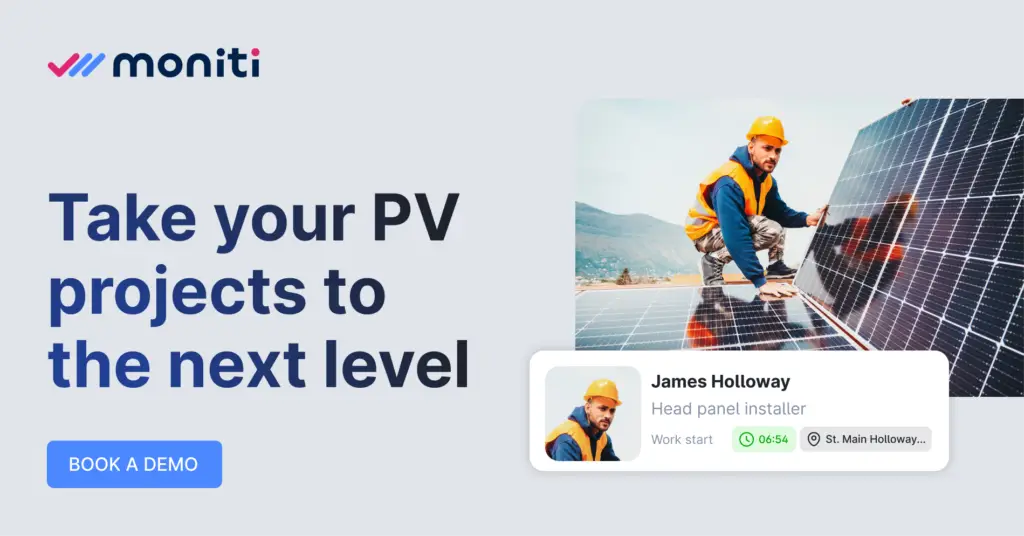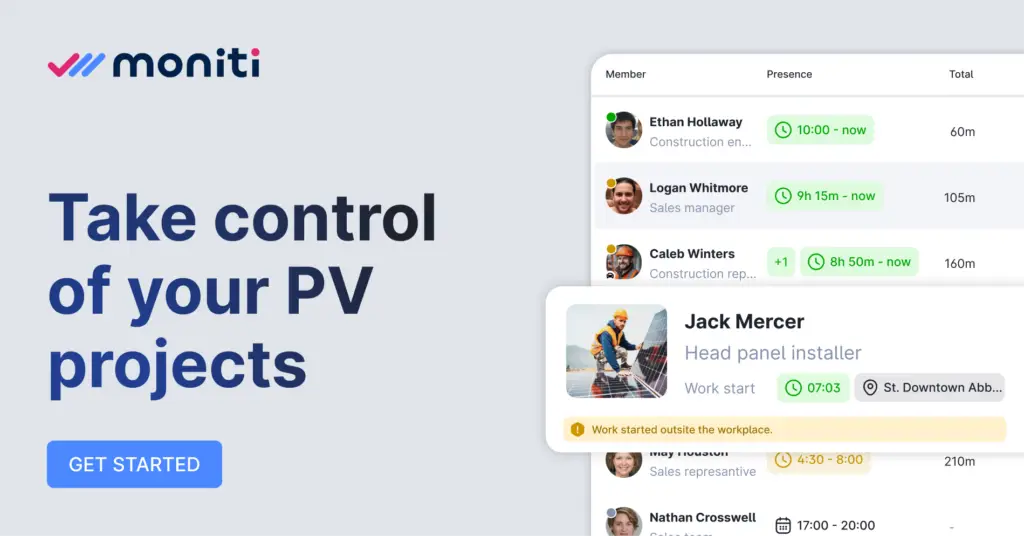Table of Contents
Comparing Photovoltaics and Solar Panels: How Do Workflows and Time Tracking Vary?
The solar energy industry has seen tremendous growth over the past few decades, with an ever-increasing focus on sustainability and renewable energy sources. Among the key technologies driving this sector are photovoltaics (PV) and solar panels, often used interchangeably in casual conversation. However, when it comes to workflows, resource allocation, and efficiency, there are significant nuances between these two terms. This article explores whether the operational workflows truly differ and highlights how tools like hours counting apps can optimize these processes.
Photovoltaics vs Solar Panels: What Are the Differences?
Before diving into workflow comparisons, it’s crucial to establish the distinction between photovoltaics and solar panels. While these terms are related, they are not identical.
- Photovoltaics (PV): Photovoltaics is the broader scientific process where solar energy is converted directly into electricity through solar cells. This term also encompasses the technology and research surrounding the materials, devices, and systems used in solar energy generation.
- Solar Panels: Solar panels, specifically photovoltaic panels, are the tangible devices installed on rooftops or solar farms to capture sunlight and convert it into electricity using PV technology. However, solar panels can also refer to solar thermal panels, which use sunlight to generate heat rather than electricity.
The distinction becomes relevant when considering workflows, as photovoltaics might involve processes ranging from R&D (R&D stands for Research and Development, a term widely used in industries to describe activities focused on innovation, improvement, and the creation of new products, technologies, or processes) and material innovation to large-scale solar farm installations, whereas workflows for solar panels often focus on manufacturing, installation, and maintenance.
Workflow Variations: Photovoltaics vs Solar Panels
Research and Development
in Photovoltaics
In the field of photovoltaics, workflows often revolve around innovation. Teams of researchers and engineers work to improve the efficiency of solar cells, develop new materials (e.g., perovskites), and optimize energy conversion rates. These workflows involve:
- Material testing: Experimenting with different semiconductor materials to improve energy efficiency.
- Prototype development: Designing and building small-scale models of PV cells for testing.
- Data analysis: Evaluating the performance of new designs under various environmental conditions.
- Commercial scaling: Transitioning successful prototypes into large-scale production.
These processes are heavily research-intensive and require precise resource allocation to maximize innovation.
If you want to find out more, you should also read this article How to optimize ROI with accurate time tracking?
Manufacturing and Installation:
Solar Panels
For solar panels, the workflows are typically more production-oriented and focused on scalability. Common processes include:
- Component manufacturing: Producing silicon wafers, assembling solar cells, and encapsulating them into durable panels.
- Quality assurance: Conducting tests to ensure panels meet efficiency and safety standards.
- Logistics and distribution: Managing supply chains to deliver panels to installation sites.
- Installation and maintenance: Planning and executing panel installation, as well as ongoing performance monitoring.
These workflows emphasize efficient production and streamlined installation processes, which require effective coordination across teams and robust tracking mechanisms.
Resource Allocation
in Solar Projects
Photovoltaics: Allocation in R&D
The allocation of resources in photovoltaic workflows often leans heavily toward intellectual and financial capital. Funding for research, procurement of advanced materials, and hiring skilled personnel are significant considerations. These workflows are iterative and dynamic, with resource needs varying depending on the stage of development.
Solar Panels: Allocation in Production and Deployment
In contrast, workflows for solar panels demand meticulous allocation of physical and human resources. Managing manufacturing equipment, coordinating installation teams, and handling logistical challenges are critical. Tools that track labor hours and streamline project timelines are invaluable here.
Do Workflows for Photovoltaics and Solar Panels Really Differ?
The key distinction lies in the scope and focus of their workflows. While photovoltaics involves broader research and technological development, solar panels are rooted in manufacturing and practical deployment. However, both processes share overlapping concerns, such as:
- Efficiency: Both workflows aim to maximize energy output while minimizing costs.
- Sustainability: Environmental considerations drive decision-making in both fields.
- Collaboration: Interdisciplinary teamwork is vital, whether in research labs or on solar farms.
Despite these similarities, the day-to-day workflows can differ significantly in terms of complexity and execution.
Optimizing Workflows
with Hours Counting Apps
One area where both photovoltaics and solar panel workflows converge is in the need for efficient time management and resource tracking. Hours counting apps can play a pivotal role in this regard by offering features such as:
- Time tracking for R&D and manufacturing teams: Ensuring that resources are allocated efficiently across different stages of the workflow.
- Project progress monitoring: Keeping track of milestones, whether in developing a new PV material or completing a solar farm installation.
- Workload distribution: Helping managers assign tasks equitably to prevent burnout and maintain productivity.
How Moniti Enhances Workflow Efficiency
Moniti is a standout tool for solar industry professionals looking to optimize workflows, streamline time tracking, and improve resource allocation. By integrating Moniti into both photovoltaic and solar panel workflows, companies can achieve:
- Accurate Time Tracking Moniti’s intuitive time tracking features ensure that every hour spent on R&D, manufacturing, or installation is recorded. This transparency allows for better planning and helps identify bottlenecks in processes.
- Enhanced Collaboration For photovoltaic research teams, Moniti facilitates seamless collaboration by offering real-time updates on project progress. Team members can log hours and share notes, ensuring that everyone remains aligned with project goals.
- Data-Driven Decisions Moniti’s reporting features provide insights into time usage. These analytics can guide decision-making, helping organizations refine their strategies and achieve greater efficiency.
If you want to learn more and choose the right tools for monitoring work time, be sure to read this article.
A Unified Approach
to Solar Workflow Optimization
While the workflows for photovoltaics and solar panels differ in focus and execution, both share a common goal: advancing renewable energy. Whether it’s through cutting-edge research in photovoltaics or the large-scale deployment of solar panels, optimizing these processes is crucial for the industry’s success.
Tools like Moniti bridge the gap by offering comprehensive solutions for time tracking and task management, ensuring that every team, regardless of its focus, operates at peak efficiency. As the solar industry continues to grow, embracing such innovations will be key to sustaining its momentum and driving the transition to a greener future.
Moniti as Your
efficiency ally
Optimizing workflows in the solar industry, whether focusing on photovoltaics or solar panels, goes beyond advanced technology—it requires effective tools to ensure smooth operations and successful outcomes. Task delegation and time tracking, once supplementary, are now essential for managing complex workflows in both R&D and installation phases.
Moniti.app stands out as a comprehensive solution that integrates task scheduling and real-time tracking into one platform. By leveraging Moniti, teams working on photovoltaics can streamline research efforts, monitor hours effectively, and ensure optimal resource allocation. Similarly, for solar panel manufacturing and deployment, Moniti enhances task assignments and tracking, ensuring seamless workflows and efficient project phases.
Implementing Moniti not only improves operational efficiency across both domains but also supports a structured, forward-thinking approach to solar project management. Whether optimizing workflows for cutting-edge photovoltaics research or large-scale solar panel installations, using tools like Moniti can make all the difference in achieving balance and boosting performance.





